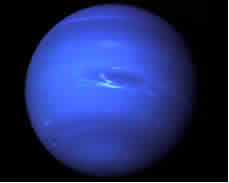
The Other Distant Giants Are Kindred Planets with Individual Quirks
Sibling giants Saturn, Uranus, and Neptune all formed from similar materials in the outer reaches of our solar system, but their hazy atmospheres hide unique quirks in their deep interiors. The giants all may have small cores of rock and solid "gases", surrounded by large volumes of liquids and gas — mostly hydrogen and helium. They have ring systems and several small moons. Like Earth and Jupiter, they have magnetic fields produced by internal processes.

Color image of Saturn taken by Cassini spacecraft. Credit: JPL/Space Science Institute/NASA
Like Jupiter, Saturn is a large, tumultuous ball of hydrogen and helium shrouded by a magnetic field, but this second-largest planet is adorned with beautiful rings. Its composition and atmosphere are similar to Jupiter's, but it is much less dense. This giant would float if there were an ocean large enough to hold it. Saturn is so much further from the Sun that its orbit takes nearly 30 Earth years to complete, but its day is a whirlwind eleven hours. Its winds are whipped to a ferocious 1100 miles(1770 kilometers)per hour! Haze high in its atmosphere masks its bands of jet streams that are similar to Jupiter's. Liquid metallic hydrogen surrounding Saturn's core is responsible for its magnetic field.
Saturn's own family of at least 62 moons and rings are currently under the scrutiny of the Cassini mission. The spacecraft is documenting a complex gravitational dance between some moons and the icy dust and boulders that make up the rings. The ring system stretches to a diameter of 175,000 miles (282,000 kilometers ) but is only 30 feet (10 meters) thick. Moons add to, twist, and sculpt the rings.
NASA's Spitzer Space Telescope has spotted a nearly invisible ring around Saturn — the largest of the giant planet's many rings. The ring is so diffuse that it reflects little sunlight, or visible light that we see with our eyes. But, its dusty particles shine with infrared light that Spitzer can see. The new belt lies at the far reaches of the saturnian system, starting about 3.7 million miles
(6 million kilometers) away from the planet and extending outward roughly another 7.4 million miles (12 million kilometers). It would take about one billion Earths stacked together to fill the thick ring. One of Saturn's farthest moons, Phoebe, circles within the newfound ring, and is likely the source of its material.
In addition to a shroud of atmospheric haze, Uranus and Neptune are concealed from our understanding by their immense distances from us. Uranus is barely visible to the naked eye, so it remained unrecognized as a planet until modern times with the aid of a telescope. The existence of Neptune was deduced mathematically and then confirmed by telescope.
Because Uranus and Neptune are so much farther from the Sun, the cold temperatures lend them unique personalities among the giants. Both are huge — four times as wide as Earth — but did not grow large enough to accumulate the massive amounts of the embryonic solar nebula that Jupiter and Saturn did. They are made of a higher percentage of water, ammonia, and methane than their larger siblings. The methane absorbs the reds and oranges from sunlight, reflecting blue and green light to back to our eyes to give them their unique blue shades. Deeper inside, hot and dense slushy layers may cover cores of rock and solid "gases," like ammonia. Uranus and Neptune's magnetic fields arise not from layers of liquid metallic hydrogen, but from currents flowing through the salty slush deep within the planets.

Uranus. Credit:. NASA, ESA, L. Sromovsky and P. Fry (University of Wisconsin), H. Hammel (Space Science Institute), and K. Rages (SETI Institute)
A giant impact may have knocked infant Uranus off-kilter and contributed to the planet's unique personality. Unlike the other planets, Uranus' axis is tilted so that the planet rotates on its side once every 17 hours. Given Uranus' long period of orbit (84 years), this translates during parts of the year into a 20-year day or night! Uranus's rings and 27 known satellites circle its equator, with the whole miniature family tipped on their sides relative to the Sun. As the parts of the northern hemisphere move out of the long winter night, astronomers are beginning to see action in its dull-looking atmosphere as these super-cold regions begin to warm. Uranus's upper atmosphere is particularly hazy and shrouds its deeper layers, but recent observations have seen long-lived storms mar the bland visage.

Uranus' axis is tilted so that the planet rotates on its side. Spring recently began in Uranus' northern hemisphere, and in 2028, a 20-year summer will begin for that side of the planet. The opposite is true for the southern hemisphere, where it is currently fall and a long winter lies ahead. Note that this drawing is not to scale.
Credit: Goldstone Apple Valley Radio Telescope Project.

Neptune.
Credit: NASA
The Sun is so far away that only a trickle of warmth reaches this furthest planet, which encircles the Sun so far out that its orbit takes 165 Earth years to complete. Like Uranus, Neptune has methane in its atmosphere, which creates a blue hue and may serve as a sort of blanket for this ultra-frigid planet. Heat left over from its formation may be trapped by the methane and help drive its extreme weather. Its winds have been clocked at 1250 miles (2000 kilometers) per hour — even faster than Saturn's — and massive storm systems move within its atmosphere. The active atmosphere made it difficult for scientists to determine how fast the planet was rotating, but the Voyager spacecraft used bursts of radio emissions generated by the magnetic field to clock the planet's 16–hour day. One of Neptune's 13 moons, Triton, is in deep freeze, with a temperature of –391°F (–200°C).


